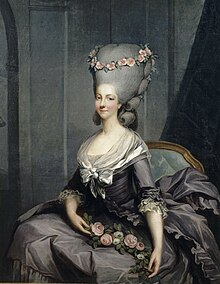Marie-Louise of Savoy-Carignan
Marie-Louise of Savoy (born September 8, 1749 in Turin , † September 3, 1792 in Paris ) was born Princess of Savoy and, through her marriage to a Bourbon prince, Princess of Lamballe ( French princesse de Lamballe ) and a member of the French royal family . As lady-in-waiting and manageress of the house of Queen Marie Antoinette , she was her closest confidante and voluntarily followed her into captivity.
Life
Marie-Louise of Savoy was the fourth daughter of Ludwig Viktor of Savoy, Prince of Carignan , the great-grandfather of King Karl Albert of Sardinia , and Christine Henriette of Hesse-Rheinfels-Rothenburg.
In 1767 she was married to Louis-Alexandre de Bourbon, prince de Lamballe (1747–1768), son of the Duke of Penthièvre , grandson of the Count of Toulouse and great-grandson of Louis XIV . When her husband died a year later, she and her father-in-law retired to Rambouillet Castle . There she lived until the marriage of the Dauphin Louis Auguste and then returned to the court of Versailles .
Marie Antoinette chose her as her closest companion and confidante. Her character was very volatile and nervous, but also extremely loyal; According to current knowledge, she suffered from a mild form of epilepsy. After her accession to the throne, Marie Antoinette appointed her, against the resistance of the king, as director of the royal household. Between 1776 and 1785, Yolande Martine Gabrielle de Polastron, duchesse de Polignac , succeeded in ousting them. But when the Queen grew tired of the Polignacs' greed, she turned to Madame de Lamballe again. From 1785 until the French Revolution , she was Marie Antoinette's closest friend.

On October 6, 1789 , she moved to the Tuileries Palace with the royal family , and since her drawing room served as a meeting place for the Queen and the members of the National Assembly , people mistook her for the person who had started all the intrigues. She held this salon once a month, and it was the only major social event the Queen attended. After traveling to England in 1791 to seek help for the royal family, she continued her services for the Queen in the Tuileries until August 10, 1792 . They were imprisoned together in the Temple .
On August 19, the princess was transferred to La Force Prison. She was not the only one from the entourage who was separated from the royal family that day. Madame de Tourzel, governess of the heir to the throne, and her daughter Pauline were also arrested. However, it is likely that Count Mirabeau was able to release Madame de Tourzel and her daughter from prison for a large sum. He also stood up for the princess, but no price was high enough. The Duke of Orleans was instrumental in this intrigue. Not only did he get his revenge on his sister-in-law, he also eliminated another heir to the old Duke of Penthievre.
When she refused to take the oath against the monarchy in court, she was handed over to the mob on September 3rd (→ September Massacre), who abused her, murdered her and carried her head around on a pike in front of the windows of the royal prison.
literature
- Elisabeth Guénard: Mémoires historiques de Marie-Thérèse-Louise de Carignan, Princesse de Lamballe, une des principales victimes des Journées des 2 and 3 Septembre 1792 . 2 volumes, Lerouge, Paris 1815 (1: digitized ; 2: digitized ).
- Mathurin F. de Lescure: La Princesse de Lamballe Marie-Thérèse-Louise de Savoie-Carignan. Sa vie, sa mort (1749-1792); d'après des documents inédits . Plon, Paris 1864 ( digitized ).
- Georges Bertin: Madame de Lamballe . 3. Edition. Paul, Paris 1903 (reprint of the 1888 edition).
- Francis Montefiore: The Princesse de Lamballe. A sketch . Richard Dentley Press, London 1896.
- Catherine Hyde, marquise de Gouvion Broglie Scolari (ed.): Secret Memoirs of Princess Lamballe: Being Her Journals, Letters, and Conversations During Her Confidential Relations with Marie Antoinette. M. Walter Dunne, New York / London 1901 ( digitized ).
- Lucien Lambeau: Essais sur la mort de madame la princesse de Lamballe . Lefebvre-Ducrocq, Lille 1902.
- Blanche C. Hardy: Princesse de Lamballe. A biography . Constable, London 1908.
- Michel de Decker: La Princesse de Lamballe. Mourir pour la pure . Pygmalion, Paris 1999, ISBN 2-85704-585-9 .
- Alain Vircondelet: La Princesse de Lamballe. L'Ange de Marie-Antoinette; biography . 2nd Edition. Flammarion, Paris 2005, ISBN 2-08-068909-6 .
Web links
| personal data | |
|---|---|
| SURNAME | Savoy-Carignan, Marie-Louise von |
| ALTERNATIVE NAMES | Savoy, Marie-Louise von; Lamballe, princesse de; Princess, Marie-Louise von (maiden name) |
| BRIEF DESCRIPTION | French lady-in-waiting, confidante of Marie-Antoinette |
| DATE OF BIRTH | September 8, 1749 |
| PLACE OF BIRTH | Turin |
| DATE OF DEATH | September 3, 1792 |
| Place of death | Paris |

